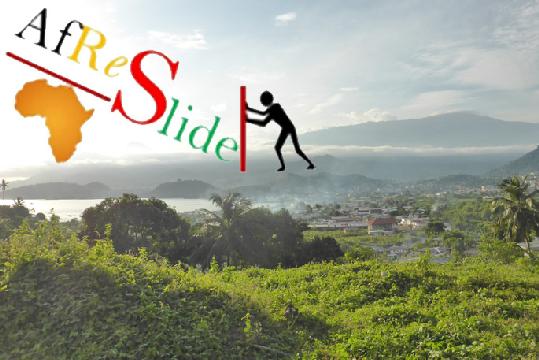Projets
AfReSlide
Landslides in Equatorial Africa: Identifying culturally, technically and economically feasible resilience strategies
Landslides (LS) cause significant impacts in many equatorial regions. Their impact depends on their size and speed, the elements at risk and the vulnerability of these elements. This problem is particularly acute in Equatorial Africa characterized by mountainous topography, intense rains, deep weathering profiles, high population density and high vulnerability to geohazards. Every year LS cause fatalities and result in structural and functional damage to infrastructure and properties. Losses from LS are expected to increase in the future in response to the demographic pressure causing more development in landslide-prone areas (LSPA), deforestation and associated changes in land use and land cover, and the changing climate causing higher or more intense rainfalls.
Many studies investigated how natural factors and human activities control the occurrence or re-activation of LS. These studies typically deliver susceptibility maps but these are insufficient to lead to efficient risk management. Building resilience requires to have a true hazard estimate, accounting not only for the spatial distribution of future LS but also for their temporal occurrence and the hazard intensity, to quantitatively analyse the socio-economic consequences of LS and to identify effective resilience strategies that are cost-effective, technically efficient and that are culturally acceptable and adapted to the livelihoods of the vulnerable population. Such an analysis is crucial as it enables to provide practical recommendations for households and policy makers to mitigate LS-related damages.
This project focuses on 4 representative study areas known for having suffered severely from rainfall-triggered LS in Uganda (Mount Elgon, Mount Rwenzori) and SW and NW Cameroon (Mount Cameroon, Bamenda). In two of these regions, some preliminary studies on LS characteristics and susceptibility mapping have been carried out, while hazard maps, a socio-economic impact analysis and resilience strategies are completely lacking. This project follows a bottom-up approach where the specific research questions, scientific data and research outputs are designed in collaboration with, and according to the needs of, the local communities and stakeholders via stakeholder meetings and participatory data collection approaches.
Information on LS is far more limited in Equatorial Africa compared to other continents. There are very few data at the continental and regional scale and it is difficult to have a clear picture of the total area affected. One of the challenges and objectives of this project is therefore to develop a methodology for resilience analysis adapted to this data-poor environment. The project will combine detailed field and remote sensing characterization of LS, socio-economic surveys of LS impact on household’s livelihood, and anthropological approaches of landslide perception and possible resilience strategies.
Many studies investigated how natural factors and human activities control the occurrence or re-activation of LS. These studies typically deliver susceptibility maps but these are insufficient to lead to efficient risk management. Building resilience requires to have a true hazard estimate, accounting not only for the spatial distribution of future LS but also for their temporal occurrence and the hazard intensity, to quantitatively analyse the socio-economic consequences of LS and to identify effective resilience strategies that are cost-effective, technically efficient and that are culturally acceptable and adapted to the livelihoods of the vulnerable population. Such an analysis is crucial as it enables to provide practical recommendations for households and policy makers to mitigate LS-related damages.
This project focuses on 4 representative study areas known for having suffered severely from rainfall-triggered LS in Uganda (Mount Elgon, Mount Rwenzori) and SW and NW Cameroon (Mount Cameroon, Bamenda). In two of these regions, some preliminary studies on LS characteristics and susceptibility mapping have been carried out, while hazard maps, a socio-economic impact analysis and resilience strategies are completely lacking. This project follows a bottom-up approach where the specific research questions, scientific data and research outputs are designed in collaboration with, and according to the needs of, the local communities and stakeholders via stakeholder meetings and participatory data collection approaches.
Information on LS is far more limited in Equatorial Africa compared to other continents. There are very few data at the continental and regional scale and it is difficult to have a clear picture of the total area affected. One of the challenges and objectives of this project is therefore to develop a methodology for resilience analysis adapted to this data-poor environment. The project will combine detailed field and remote sensing characterization of LS, socio-economic surveys of LS impact on household’s livelihood, and anthropological approaches of landslide perception and possible resilience strategies.
The specific objectives of the present project are:
- to produce LS susceptibility maps and identify return periods of LS-triggering rainfall events to estimate hazards for 4 representative study areas;
- to analyse the types of elements at risk (immaterial and material) and their exposure, and to develop a methodology to economically value the consequences,
- to assess current and potential resilience strategies at household and at policy levels;
- to analyse the cultural premises underlying perceptions of environmental threats, to describe land rights and land management, and to identify culturally acceptable resilience strategies;
- to produce risk maps and provide recommendations for the most effective resilience strategies.
